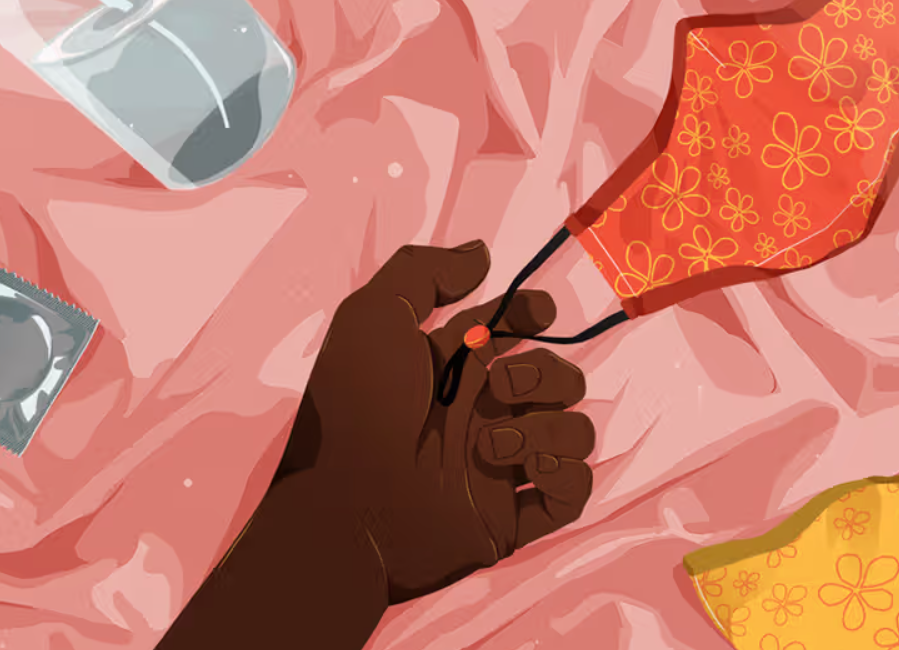A Realistic Guide to Safer Sex During COVID-19

After 12+ months of mumbling “I’m my safest sex partner!” while rubbing one out, you’re probably wondering when you can start having in-person partnered or multi-partnered sex again.
The answer: potentially sooner than you think!
Scroll on to learn more about safer romping in the age of ‘rona.
First: What is safer sex, exactly?
Before we talk about how to have safer sex during the coronavirus pandemic, we need to talk about what safer sex is.
Typically, safer sex is defined as sex — that’s any meaningful experience of pleasure — that helps reduce the risk of sexually transmitted infections (STIs).
Common ways of reducing the risk of STI transmission include:
- using an external condom, internal condom, dental dam, or other barrier method
- getting regularly tested for STIs
- exchanging your STI status with your partner(s)
- taking pre-exposure prophylaxis (PrEP) if you’re at risk of contracting HIV
The reason it’s known as safer (with the r), and not safe sex, is because no transmission inhibitor is 100 percent effective.
External condoms, for example, aren’t foolproof. Some data shows that, when taking human error into consideration, they’re only 85 percent effective.
Even being screened for STIs isn’t 100 percent effective. This isn’t because the tests are inaccurate — they are accurateTrusted Source — but because most doctors don’t screen for all STIs or don’t screen for all STIs in all possible infection locations.
Many doctors, for example, won’t test for the herpes simplex virus unless you’re currently experiencing an outbreak. In fact, the Centers For Disease Control and Prevention (CDC)Trusted Source actually recommends against it.
Similarly, most doctors don’t ask people if they’ve engaged in oral or anal sex, and they may fail to test for oral or anal STIs.
The definition of safer sex changes during a pandemic
Gone are the days when safer sex spoke only to the risk of STI transmission.
In the midst of a global pandemic centered around a virus that can be spread through a variety of bodily fluids — respiratory dropletsTrusted Source, mucus, semenTrusted Source, fecal matterTrusted Source, and bloodTrusted Source — the definition of safer sex has expanded.
These days, safer sex is defined as sex where those involved proactively work to reduce the risk of potential STI and COVID-19 transmission.
Here are some additional precautions to take during the pandemic to reduce your risk of COVID-19 transmission:
- Get regularly tested for COVID-19.
- Get a COVID-19 vaccine, and continue to physically distance until you’re considered fully vaccinated.
- Wear a mask (or two).
- Stay 6 (or more) feet apart from those outside of your household or pod.
- Disinfect surfaces that are going to be shared by multiple people.
- Wash your hands before and after sexual activity.
- Disinfect any shared sex toys after use.
- Avoid sexual activities that have a higher risk of infection.
No, COVID-19 isn’t a sexually transmitted infection
To be very clear: Although STIs and COVID-19 can both be spread during sex, COVID-19 is not classified as an STI.
This means that, even if you get screened for every single STI, you aren’t also getting screened for COVID-19.
The only way to know if you’ve contracted COVID-19 is to take a COVID-19 test.
Step 1: Become informed
Part one of safer sex during the COVID-19 pandemic is understanding how the two types of infections work.
How COVID-19 is transmitted
COVID-19 is primarily spread upon contact with respiratory droplets — like sneeze shmutz, cough gook, and spit — from a person with COVID-19 coughing, sneezing, or talking near you.
COVID-19 can alsoTrusted Source be spread through airborne transmission.
Learn more about how COVID-19 is transmitted by visiting the U.S. Food and Drug Administration (FDA)Trusted Source and CDCTrusted Source websites.
How STIs are transmitted
STIs are primarily transmitted through bodily fluids or direct genital skin-to-skin contact.
Learn more about STI transmission below:
- Everything You Need to Know About Sexually Transmitted Diseases (STDs)
- Oral STDs: What Are the Symptoms?
- What to Expect from Anal STI Testing — and Why It’s a Must
- Can You Get an STI from a Hand Job? And 9 Other Questions, Answered
- Can You Actually Give Yourself An STI?
Step 2: Learn about your own health
Do you know your current STI or COVID-19 status? Find out before boning.
Find out your COVID-19 status
The only way to know your COVID-19 status is to get tested, eliminate as many potential risks for transmission between the test and results, and receive your results.
Throughout the pandemic, recommendations around whether people who aren’t experiencing symptoms should get tested have varied.
To find if you qualify for a test, and where you can get tested:
- Google search “COVID-19 testing near me.”
- Call your local clinic, doctor, or other healthcare professional.
- Ask your local urgent care, CVS, or Walgreens if they’re currently performing COVID-19 tests.
To learn more about COVID-19 testing, check out the FDA’s Coronavirus Disease Testing BasicsTrusted Source or read the below Healthline articles:
- Vaccinated or Not, COVID-19 Testing Is Still Important: Here’s Why
- Home COVID-19 Tests: Availability, Accuracy, and How They Work
- What to Know About COVID-19 Diagnosis
Find out your STI status
Knowing your true STI status means getting tested for all STIs.
“Prior to any sexual encounter, it’s recommended that all partners be screened for HIV, hepatitis B, gonorrhea, chlamydia, syphilis, and herpes,” says Kecia Gaither, MD, a double board certified physician in OB-GYN and maternal fetal medicine and the director of perinatal services at NYC Health + Hospitals/Lincoln.
It also means getting screened in all potential areas at risk of being infected. In other words, get tested for oral or anal STIs if you have oral or anal sex.
If you aren’t sure where to go, check out our roundup of STI testing locations available in each state and online.
Step 3: Share your STI status with your potential partner(s)
Your STI status isn’t the only one you need to know before you have partnered or multi-partnered sex.
You also need to know the status of the people you’re bedding.
To introduce the STI conversation, share your status first, recommends Lisa Finn, a sex educator and sexpert with sex toy boutique Babeland.
“Sharing your status and testing protocols will make other people feel more comfortable sharing their status,” she says.
You might say:
- “Before you come over, I’d love to talk about our STI status. I’ll start: I got tested for gonorrhea, HIV, chlamydia, and trichomoniasis 2 weeks ago and received negative results for everything. HBU?”
- “Before we meet up, I want to find out my current STI status. I’m going to make an appointment at my local Planned Parenthood or walk-in clinic this week. When were you last tested? Would you be open to doing the same?”
- “I’m really excited to see you. I want you to know that I’m herpes positive, I’m on antiretrovirals, and I haven’t had an outbreak in 6 months. Let me know if you have any questions.”
Step 4: Discuss your COVID-19 status and potential exposures
Before agreeing to meet up with someone, Gaither says, “You want to find out when their last negative (or positive) COVID-19 test was, if they’re fully vaccinated, if and when they’re planning to get vaccinated, what their safety protocols are, and if they’ve had any recent exposures.”
Gigi Engle, a certified sex coach and the author of “All The F*cking Mistakes: A Guide to Sex, Love, and Life,” notes that you might also ask how many people they’re currently dating.
“This is a very serious virus, and it deserves to be treated with seriousness,” she says.
“It’s not unchill to ask someone to help you assess whether they’re going to give you a potentially life threatening infection.” Fair!
Having different COVID-19 protocols may be a dealbreaker, and that’s OK!
“It may be a red flag if someone follows different COVID-19 protocols than you and refuses to adjust to the precautions you’ve requested in order to feel safe,” Engle says.
“It certainly indicates that this person isn’t being safe with their own health, which puts you at even greater risk.”
Step 5: Chat about specific sex acts and positions
Ultimately, if you each aren’t fully vaccinated, having in-person sex in the middle of the pandemic with someone outside your household is risky.
But, according to the NYC Health Department, certain acts are safer than others.
According to the NYC Health Department, the safest sex acts during the pandemic include:
- mutual masturbation
- glory hole sex
- masked sex
- oral sex with a dental dam or external condom
- anal sex with an external condom or other barrier method
Swapping spit is on the riskier side. Rimming is considered risky, too.
That doesn’t mean you can only do the acts the NYC Health Department approves of.
It just means you should approach other acts with an understanding of the risks.
If COVID-19 transmission is a concern, there’s always virtual sex
Over a year into the pandemic, you’re probably a little sick (pun intended) of reading articles that sing the praises of sexting, phone sex, and video banging.
But, as Engle says, “Virtual sex really can be fun and intimate!”
App-controlled sex toys, mood lighting, good WiFi connections, and unlimited messaging can all help.
“We’ll all be vaccinated soon, and life can go back to normal in the near future,” she says. “Right now, [you] need to play it safe, even if you’d prefer to have sex in person.”
The bottom line
It is possible to have in-person (!) partnered and multi-partnered sex in the middle of the pandemic.
It just requires a lot of communication ahead of time about certain things, like COVID-19 protocols, current STI status, boundaries, and more.

